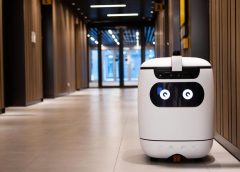
These cute robots could deliver your next coffee
[ad_1]
(CNN) — Trundling around the hallways of Hong Kong’s Cyberport innovation hub, the little Rice Robot is on a mission.
The stocky white cuboid resembles Star Wars’ R2D2 robot in its build, but has the wide-eyed expression of Pixar’s WALL-E. It’s delivering drinks to patrons of the HFT Life cafe in a compartment in its “head” which is unlocked by the customer using a PIN code sent to their phone.

Customers receive a PIN code, enabling them to open the hatch in Rice’s “head” to retrieve their drinks.
Rice Robotics
Describing Rice as “your friendly neighborhood robot,” Lee hopes it can help the hospitality sector combat labor shortages as the population ages, while appealing to the post-pandemic demand for heightened hygiene protocols.
“Even after COVID, people are paying a lot of attention to contact,” says Lee. He believes “this type of delivery robot will see steady growth in next five and 10 years.”
Pandemic robot boom
With a background in logistics, Lee founded Rice Robotics in 2019 to solve the challenge of “last-mile delivery.”
Supported by the Cyberport Incubation Programme, Lee and his team developed Rice, the first of its three robots. Designed for delivering goods, it can be used in healthcare, retail, logistics and hospitality.
The Dorsett Wanchai hotel started using Rice robots in June 2021. “It’s a great way to serve our guests and to maintain our service standards while adhering to social distancing and anti-pandemic measures,” says general manager Anita Chan, adding that feedback from guests has been positive: “With its cute appearance, Rice Robot is especially loved by the kids.”

During the pandemic, the Dorsett Wanchai hotel in Hong Kong introduced a team of high-tech robots, including droids for cleaning and sanitizing, and Rice for contactless room service.
Dorsett Wanchai
Lee says that during the pandemic, clients began asking about cleaning robots. His team responded by developing a second robot, called Jasmine, in just eight weeks. Replacing Rice’s delivery compartment with a tank of sanitizing solution, Jasmine has two spray nozzles on her head to disperse disinfectant.
Lee created a new personality for Jasmine — which has already been deployed in malls, conference centers and airports — by giving her cartoon eyebrows that furrow in a serious expression. “She has to go out and sanitize the whole place, and she doesn’t want anyone to get in her way,” says Lee.
The team’s third product, Portal, is a taller robot with a touch screen, two-way intercom and streaming cameras for patrolling public areas. As well as making deliveries, Portal can guide visitors in venues such as shopping malls, conference centers and hospitals.
Hospitable robots
While industrial robots are commonplace in the automotive, manufacturing and electronics sectors, until recently most service robots in hospitality were used for novelty purposes.
But the pandemic has changed that, says Kaye Chon, dean of the School of Hotel and Tourism Management at the Hong Kong Polytechnic University.
In response to travel and social restrictions, “there was an exodus of employees in our industry,” says Chon. Combined with concerns about hygiene and a growing acceptance of smart tech from younger customers, Chon sees robotics as the next step in the hospitality industry’s “digital transformation.”
However, the technology still has to overcome some hurdles to achieve the same efficiency as industrial robots. Costs are still high for this technology — Rice Robotics’ products cost from $9,000 per unit — and malls, hotels, and restaurants need to be adapted to be robot-friendly, says Chon.
Staff also need to know how to program the robots, a skill set that is lacking in the industry. To remedy this, Chon helped devise a new “smart tourism” curriculum covering AI, robotics, and big data, but says it will take time for current students to enter the workforce. “This is the way our industry is evolving,” he adds.

Portal, Rice Robotics’ third product, is taller with a touch screen, two-way intercom and streaming cameras for patrolling public areas — such as Captain C, pictured at the Hong Kong Exhibition and Convention Center.
Rice Robotics
Rice Robotics has created a fleet management app for users, and helps clients make infrastructural changes, such as programming the robots and elevator systems to communicate with each other. The startup also offers its robots on a monthly subscription service, starting at $800 per unit, which includes technical and on-site support.
And while robots can help to minimize contact between people, they still need to be sanitized by staff between uses, says Chon.
Chon sees great opportunity for robots to perform simple, repetitive tasks in budget and mid-range hotels — but the technology is still a long way from replicating the “small, personal touches” that high-end luxury properties sell themselves on, he adds.
Rapid expansion

Lee says robots like Rice can help reduce the cost of “last-mile delivery” and increase efficiency.
Rice Robotics
Rice Robotics has expanded rapidly during the pandemic, from an three-person team in 2019 to 26. Now based in the Hong Kong Science and Technology Park, the company opened an office in Japan in 2021 to help manage its growing client base there. With a rapidly aging population, Lee says robots are essential to support Japan’s retail and hospitality sectors.
Beyond hospitality, Lee sees robots becoming more common in our homes, too. In a recent project with Japan’s postal service, several Rice units were deployed in a high-rise building to help deliver parcels and mail to residents’ doors.
“Robots are not taking people’s jobs, but rather trying to help keep society moving,” says Lee, adding: “Robots are the future.”
[ad_2]
Source link


